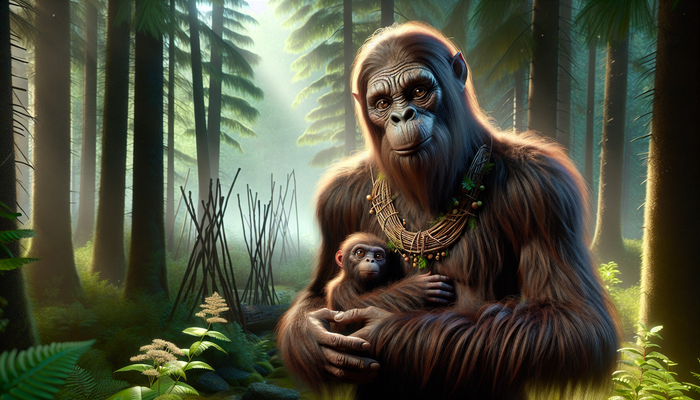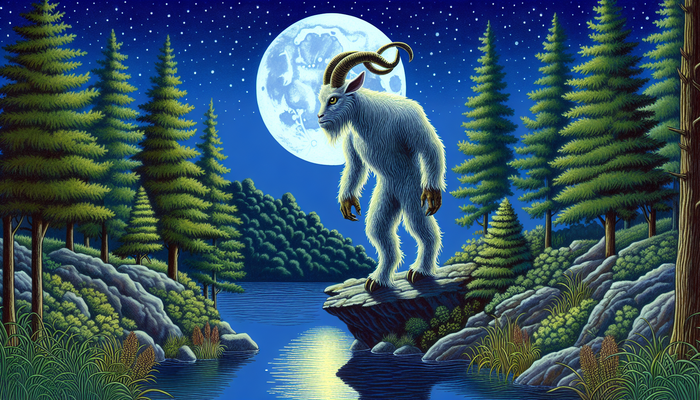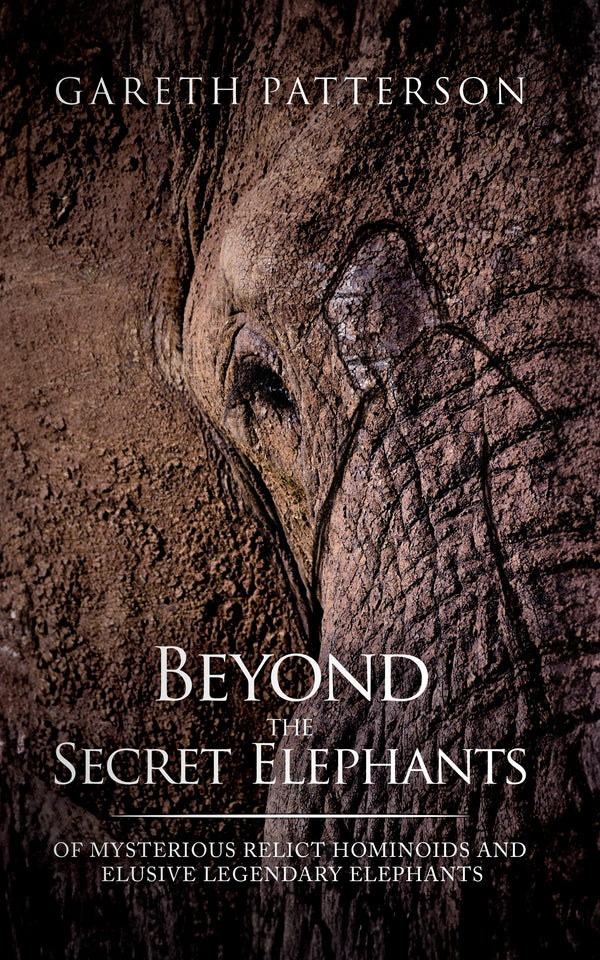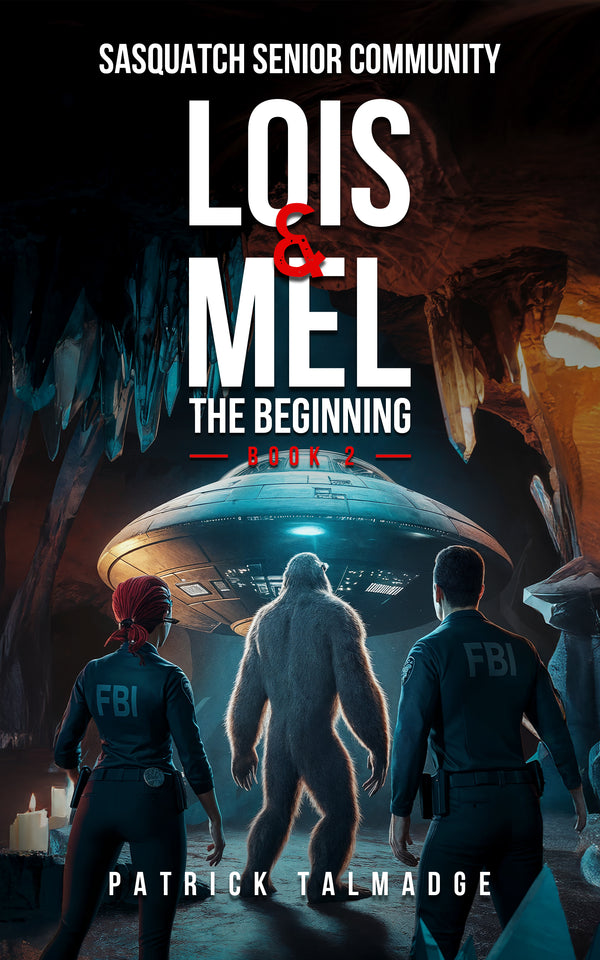The Tennessee Wildman: Unraveling the Legend of Appalachia's Fearsome Cryptid
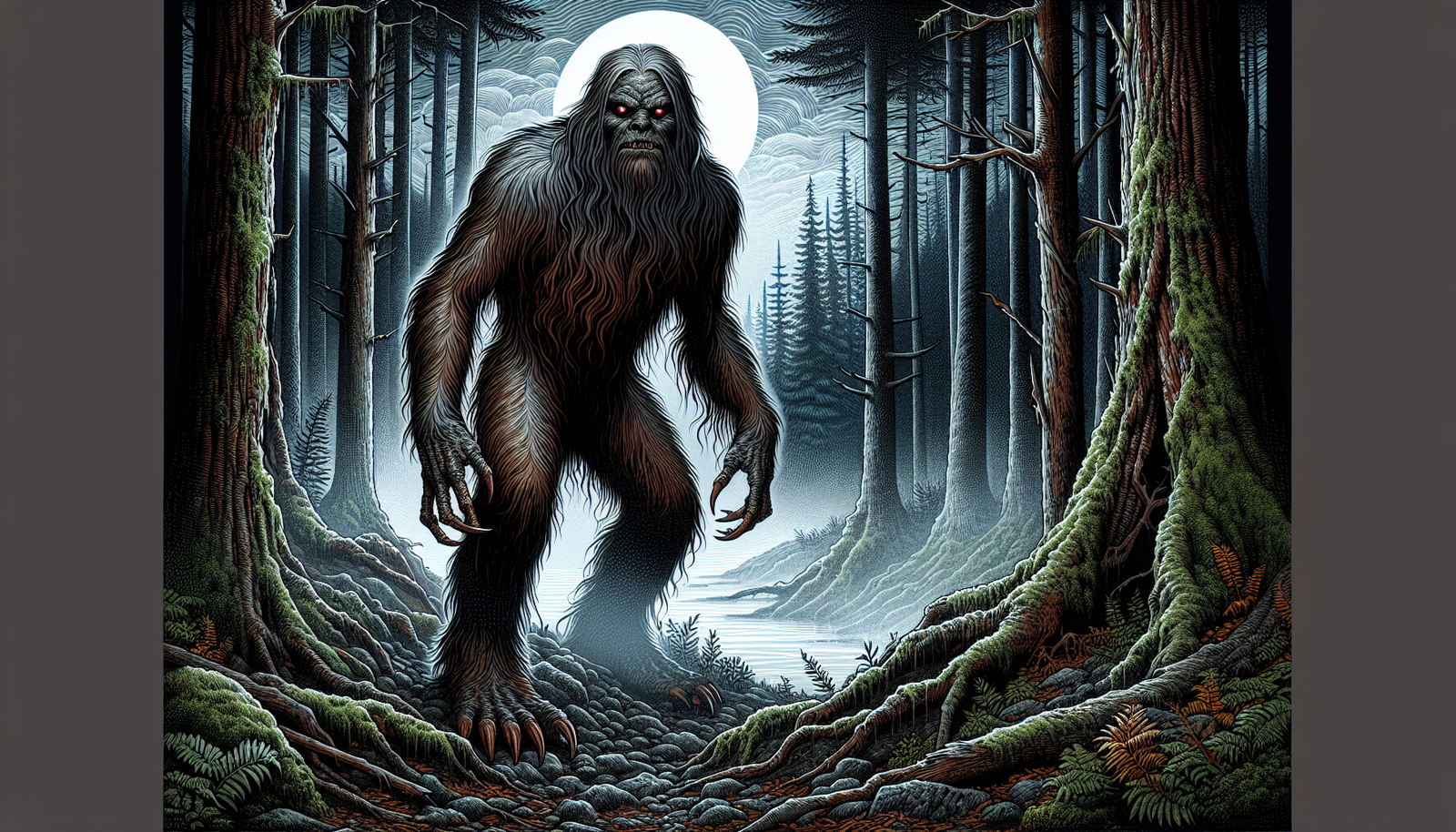
By Ava Martinez, Cryptozoologist
Historical Context and Origins
The tale of the Tennessee Wildman didn't spring fully formed from the forests of Appalachia. Like many cryptids, its origins are rooted in a complex tapestry of historical events, cultural shifts, and age-old human fears. To truly understand the Wildman, we must first step back in time to the post-Civil War era, when the first documented sightings began to emerge.
The year was 1871, and the wounds of the Civil War were still fresh in the American psyche. It was in this tumultuous time that the Hagerstown Mail, a Maryland newspaper, published an article that would set the stage for over a century of Wildman lore. The piece described a "strange and frightful being" spotted in McNairy County, Tennessee. This creature, standing seven feet tall and covered in matted hair, was said to approach women with "wild, horrid screams" while fleeing from men with astonishing speed.
But why did this particular legend take root at this moment in history? The answer lies in the social and psychological landscape of post-war America. The Civil War had shattered the nation's sense of order and security. In its wake, many Americans found themselves grappling with a world that seemed increasingly chaotic and unpredictable. The idea of a wild, untamed creature lurking just beyond the edges of civilization resonated deeply with these anxieties.
Moreover, the late 19th century saw a surge of interest in the natural world and the "frontier spirit" that had long defined American identity. As the country expanded westward, tales of strange creatures and unexplored wilderness captured the public imagination. The Tennessee Wildman, with its blend of human and animal characteristics, embodied this fascination with the unknown and the untamed.
It's worth noting that the concept of a "wild man" was not unique to Tennessee or even to America. European folklore had long been populated by similar figures, known variously as woodwoses, wodewoses, or simply "wild men of the woods." These creatures, often depicted as hairy, primitive humans living outside the bounds of civilization, had been a staple of medieval art and literature for centuries.
The parallels between these European legends and the Tennessee Wildman are striking. Both represent a kind of "missing link" between humanity and the natural world, embodying our fascination with and fear of our own primal nature. In the Tennessee Wildman, we see echoes of these ancient archetypes, adapted to the specific cultural and geographical context of the American South.
As the legend of the Wildman grew, it began to take on distinctly Appalachian characteristics. The creature became associated with specific locations, like the dense forests of McNairy County and the rugged terrain of the Cumberland Plateau. Its behavior and appearance were described in increasingly vivid detail, shaped by the experiences and imaginations of those who claimed to have encountered it.
One particularly intriguing aspect of the Wildman's early history is its connection to the circus and sideshow culture of the late 19th and early 20th centuries. Some accounts suggest that the creature was actually captured and exhibited as a "freak" attraction before escaping back into the wild. While these stories are likely apocryphal, they speak to the way in which the Wildman legend intersected with broader cultural trends and entertainment practices of the era.
As we move into the 20th century, the legend of the Tennessee Wildman continued to evolve. The rise of cryptozoology as a pseudo-scientific field in the mid-20th century brought new attention to creatures like the Wildman, placing them alongside other famous cryptids like Bigfoot and the Loch Ness Monster. This shift in perspective transformed the Wildman from a local folktale into a subject of serious investigation for some, and a source of ridicule for others.
Today, the historical origins of the Tennessee Wildman serve as a fascinating case study in the way folklore adapts and persists over time. From its roots in post-Civil War anxiety to its modern status as a cryptozoological curiosity, the Wildman has remained a powerful symbol of the mysterious and the unknown. Its story is a testament to the enduring human need to find wonder and mystery in the world around us, even as our understanding of that world continues to grow.
Physical Description
When it comes to describing the Tennessee Wildman, eyewitness accounts paint a picture of a creature that is both awe-inspiring and terrifying. Standing between seven and nine feet tall, the Wildman towers over even the tallest human, its massive frame a testament to the raw power of nature unleashed. But it's not just the creature's size that sets it apart – it's the combination of human and animal characteristics that make it truly unique.
Imagine, if you will, a being that seems to have stepped out of humanity's distant past, a living embodiment of our primal origins. The Wildman's body is covered in a thick coat of hair, ranging in color from dark gray to a rich, reddish-brown. This isn't the well-groomed fur of a domesticated animal, but a wild, matted tangle that speaks of a life spent in the depths of the forest, far from the comforts of civilization.
But it's the Wildman's face that truly captures the imagination. Peering out from beneath a heavy brow, its eyes are said to glow with an otherworldly light, ranging from a fierce, burning red to a deep, smoldering orange. These eyes, described by some witnesses as "piercing" or "hypnotic," seem to possess an intelligence that goes beyond mere animal cunning. It's as if the creature is not just seeing you, but looking into your very soul.
The Wildman's hands are another point of fascination. Described as large and powerful, they end in long, sharp claws that could easily rend flesh or wood. These aren't the delicate fingers of a human, but the tools of a predator, equally suited for climbing trees or tearing apart prey.
One of the most consistently reported features of the Tennessee Wildman is its odor. Witnesses describe an overpowering stench, reminiscent of rotting flesh or decaying vegetation. This smell is often the first sign of the creature's presence, lingering in the air long after it has passed. Some researchers speculate that this odor might serve a territorial function, warning other creatures (including humans) to stay away.
When compared to other cryptids, the Tennessee Wildman occupies a unique space. While it shares some characteristics with Bigfoot – notably its size and bipedal nature – there are key differences. The Wildman is often described as more aggressive and territorial than its Pacific Northwest cousin. Its glowing eyes and more human-like features also set it apart, suggesting a creature that is perhaps closer to humanity on the evolutionary scale.
Interestingly, the physical description of the Wildman has remained remarkably consistent over the years, despite the legend spanning more than a century. This consistency lends a certain credibility to the reports, although skeptics argue that it could also be the result of later sightings being influenced by earlier descriptions.
One particularly intriguing aspect of the Wildman's physiology is its apparent adaptability to different environments. While most sightings occur in densely forested areas, there have been reports of the creature near rivers and even in more open terrain. This suggests a level of intelligence and adaptability that goes beyond what we might expect from a simple animal.
The Wildman's physical capabilities are also a source of wonder and fear. Witnesses describe a creature of incredible strength, able to uproot small trees or toss heavy objects with ease. Its speed and agility are equally impressive, with reports of the Wildman outrunning horses and leaping over fences "with the ease of a deer."
But perhaps the most chilling aspect of the Wildman's physicality is its voice. The creature is said to emit a scream that is unlike anything in nature – a sound that combines the raw power of a wild animal with an almost human-like quality that sends shivers down the spine. This vocalization, more than any other feature, seems to capture the essence of the Wildman as a being that exists on the border between the human and animal worlds.
As we consider the physical description of the Tennessee Wildman, it's important to remember that we're dealing with eyewitness accounts, often made under conditions of extreme stress or fear. The human mind has a remarkable ability to fill in details and make connections, especially when confronted with something outside our normal experience. This doesn't necessarily mean that the Wildman doesn't exist, but it does require us to approach these descriptions with a critical eye.
Behavior and Characteristics
The behavior of the Tennessee Wildman is as fascinating and terrifying as its physical appearance. This is not a gentle giant of the forest, but a creature of fierce temperament and unpredictable actions. Understanding the Wildman's behavior is key to unraveling the mystery of its existence and its impact on the communities that share its alleged habitat.
One of the most striking aspects of the Wildman's behavior is its aggression. Unlike many cryptids, which are often described as shy or elusive, the Tennessee Wildman is frequently reported as confrontational and territorial. Witnesses describe encounters where the creature actively approaches humans, sometimes even chasing them out of what it perceives as its territory.
This aggressive behavior seems to be particularly pronounced when it comes to dogs and women. Numerous accounts tell of the Wildman attempting to snatch dogs, perhaps seeing them as easy prey or as a threat to its dominance. Even more chilling are the reports of the creature's apparent obsession with women. While there are no confirmed cases of successful abductions, the frequency of these attempted "kidnappings" has become a defining characteristic of the Wildman legend.
But why this focus on women? Some researchers speculate that it could be a misinterpretation of mating behavior, suggesting that the Wildman might view human females as potential mates. Others see it as a reflection of societal fears about the vulnerability of women in isolated rural areas. Whatever the reason, this aspect of the Wildman's behavior has contributed significantly to its fearsome reputation.
The Wildman's vocalizations are another key aspect of its behavioral profile. The creature is said to emit a variety of sounds, from low, guttural growls to high-pitched, piercing screams. These vocalizations are often described as being unlike anything in nature, combining elements of human and animal sounds in a way that is deeply unsettling to those who hear it.
One witness described the Wildman's scream as "a sound that freezes your blood and makes your hair stand on end." Another likened it to "a woman being murdered, mixed with the roar of a mountain lion." These descriptions paint a picture of a creature that uses sound not just for communication, but as a tool for intimidation and territorial marking.
Interestingly, the Wildman is also said to exhibit some behaviors that suggest a higher level of intelligence than one might expect from a mere animal. There are accounts of the creature using simple tools, such as sticks or rocks, either as weapons or for foraging. Some witnesses have even reported seeing the Wildman engage in what appears to be primitive communication, using gestures or arranged objects in ways that seem purposeful.
This apparent intelligence has led to speculation about the Wildman's origins and nature. Is it a surviving member of an ancient hominid species, possessing a level of cognition somewhere between modern humans and our evolutionary ancestors? Or could it be something else entirely – a being that has evolved alongside us but remained hidden in the depths of the wilderness?
One of the most intriguing aspects of the Wildman's behavior is its reported interactions with other cryptids, particularly Sasquatch. Some accounts suggest a rivalry between the two species, with territorial disputes and even physical confrontations. This idea of cryptid-on-cryptid conflict adds another layer of complexity to the Wildman legend, suggesting a hidden ecosystem of unknown creatures existing just beyond the edge of human knowledge.
The Wildman's habitat preferences also offer clues to its behavior. While it's most commonly associated with dense forests, particularly in the eastern part of Tennessee, there have been sightings in a variety of environments. This adaptability suggests a creature that is intelligent and resourceful, able to survive in different terrains and potentially evade human detection.
Food sources for the Wildman remain a topic of speculation. While some reports suggest it's carnivorous, preying on livestock and wild animals, others describe it foraging for plants and berries. This omnivorous diet would be consistent with known primate behavior and could explain the creature's ability to survive in diverse habitats.
Perhaps one of the most chilling aspects of the Wildman's behavior is its apparent ability to instill a deep, primal fear in those who encounter it. Many witnesses report feeling an overwhelming sense of dread or panic in the creature's presence, even before they've fully registered what they're seeing. This psychological impact goes beyond normal fear of the unknown, suggesting that the Wildman taps into something deep in our evolutionary past – a reminder of a time when humans were not at the top of the food chain.
As we consider the behavior and characteristics of the Tennessee Wildman, it's important to remember that we're dealing with a creature that, if it exists, has successfully evaded definitive scientific documentation for over a century. Its behavior, as described by witnesses, paints a picture of a being that is both animal and something more – a creature that challenges our understanding of the natural world and our place in it.
Whether the Tennessee Wildman is a flesh-and-blood animal, a supernatural entity, or a product of human imagination, its reported behavior continues to captivate and terrify in equal measure. It serves as a reminder that, even in our modern world, there are still mysteries to be solved and frontiers to be explored – if we dare to venture into the unknown.
Notable Sightings and Encounters
The legend of the Tennessee Wildman is built on a foundation of eyewitness accounts, each one adding to the mystique and terror surrounding this elusive creature. From the earliest documented sightings in the 19th century to modern-day encounters, these reports paint a vivid picture of a being that continues to elude definitive explanation.
Let's start with that seminal 1871 account published in the Hagerstown Mail. The article described a creature terrorizing the area between Sobby and Crainsville in McNairy County. This early description set the template for many future sightings: a seven-foot-tall being with "great muscular power," covered in hair, with fiery red eyes. The creature was said to approach women with "wild and horrid screams of delight" while fleeing from men with incredible speed and agility.
This initial report sparked a wave of sightings and encounters across Tennessee. In the decades that followed, the legend of the Wildman grew, fueled by a mix of genuine fear and frontier tall tales. One particularly intriguing account from the late 19th century tells of a group of hunters who claimed to have tracked the Wildman to a cave deep in the mountains. There, they found a lair littered with animal bones, suggesting a creature that was both intelligent enough to use shelter and powerful enough to take down large prey.
As we move into the 20th century, the sightings become more detailed and, in some cases, more terrifying. In 1934, multiple witnesses in South Pittsburgh, Tennessee, reported seeing "baboon-like creatures" bounding across fields and roads with incredible speed. While not explicitly identified as the Wildman, these sightings fit the general profile and suggest a possible expansion of the creature's range.
One of the most famous modern encounters with the Tennessee Wildman occurred in the late 1990s near Elizabethton. Robb Phillips, a paranormal investigator, and his cousin Randy Sparks were hiking in the Watauga Cliffs area on a rainy evening when they had a chilling experience. Phillips recounts that the forest suddenly went silent, followed by the sound of snapping twigs and an "horrible inhuman scream." The men fled in different directions, with Phillips hiding behind a tree. It was then that he claims to have spotted the Wildman clinging to a nearby tree, about 15 feet away.
Phillips' description of the creature aligns closely with earlier accounts: a massive, hair-covered being with glowing red eyes and a horrific stench. What makes this encounter particularly compelling is Phillips' background in paranormal investigation. As someone familiar with analyzing unusual phenomena, his detailed account carries a certain weight in the cryptozoology community.
Another significant incident occurred in 1981 in Rockwood, Tennessee. Two brothers reported their dog becoming agitated, leading them to discover a large, hair-covered creature holding the dog at the edge of the woods. When they fired shots at the being, it let out a blood-curdling scream before disappearing into the forest. This encounter is notable for its similarity to earlier reports of the Wildman's interest in dogs and its aggressive behavior when confronted.
It's not just isolated incidents that make up the Wildman's story. Entire communities have reported waves of sightings and strange occurrences. In the 1970s, the town of Flintville, Tennessee, became a hotbed of Wildman activity. Residents reported numerous sightings of a large, ape-like creature that seemed to be living in the surrounding woods. The situation reached a fever pitch when a woman claimed the creature had attempted to snatch her child from their backyard.
These community-wide experiences are particularly interesting because they suggest a pattern of behavior and movement that goes beyond random encounters. They raise questions about the creature's territorial nature and its ability to adapt to increased human presence in its habitat.
One of the most intriguing aspects of Wildman sightings is the consistency of the descriptions over time. Despite changes in culture, technology, and our understanding of the natural world, the core elements of the Wildman's appearance and behavior have remained remarkably stable. This consistency lends a certain credibility to the reports, although skeptics argue that it could also be the result of cultural transmission of the legend influencing later sightings.
It's worth noting that not all encounters with the Wildman are visual. Many reports focus on the creature's distinctive vocalizations or the lingering odor it leaves behind. These sensory experiences can be just as terrifying as a direct sighting, perhaps even more so because they leave more to the imagination.
For example, in 2009, a couple camping along the Duck River in Hickman County reported hearing a "loud, deep howl" that silenced all other wildlife in the area. While they never saw the source of the sound, they were convinced it was the call of the Wildman. This type of auditory encounter is common in cryptid reports and adds another layer to the mystery surrounding the creature.
As we consider these sightings and encounters, it's important to approach them with a critical eye. Many can be explained by misidentification of known animals, particularly in low-light conditions or situations of high stress. Bears, in particular, can appear remarkably human-like when standing on their hind legs and are known to make vocalizations that can sound unnervingly human.
However, the sheer volume of reports and the consistency of the descriptions over time suggest that there may be more to the story of the Tennessee Wildman than simple misidentification or hoaxes. Whether it's a yet-undiscovered species, a surviving population of an ancient hominid, or something else entirely, the Wildman continues to capture the imagination and spark debate among cryptozoologists and skeptics alike.
These encounters, spread across more than a century, have shaped the legend of the Tennessee Wildman and cemented its place in the pantheon of American cryptids. They serve as a reminder that, even in our modern world, there are still mysteries to be solved and unexplored corners of the wilderness where the unknown may still lurk.
Cultural Significance
The Tennessee Wildman is more than just a cryptid – it's a cultural phenomenon that has left an indelible mark on the folklore, art, and collective psyche of Appalachia. To understand the full impact of this mysterious creature, we need to look beyond the sightings and encounters to examine how it has shaped the communities that share its alleged habitat.
At its core, the legend of the Wildman taps into something primal in the human psyche – our fascination with and fear of the unknown. In the densely forested regions of Tennessee, where civilization gives way to wilderness, the Wildman serves as a powerful symbol of the untamed natural world. It reminds us that, despite our technological advancements, there are still aspects of our environment that remain beyond our control or understanding.
This symbolic role has made the Wildman a popular figure in local storytelling traditions. Around campfires and in family gatherings, tales of the creature are passed down from generation to generation, each retelling adding new layers to the legend. These stories serve multiple purposes – they entertain, of course, but they also act as cautionary tales, warning children (and adults) about the dangers that lurk in the wild.
"Don't go into the woods alone," a parent might say, "or the Wildman might get you." This use of the Wildman as a boogeyman figure is a common thread in many cryptid legends, but it takes on a particular resonance in the context of Appalachian culture, where respect for the natural world is deeply ingrained.
The Wildman has also found its way into local art and literature. Folk artists have created countless depictions of the creature, ranging from terrifying to almost comical. These artistic interpretations not only keep the legend alive but also provide a way for communities to process and express their relationship with the wilderness that surrounds them.
In literature, the Wildman has inspired everything from serious works of cryptozoological investigation to children's books and horror novels. One particularly interesting example is Robert Frank McKinney's 1976 novel "Torment in the Knobs," a fictionalized account of the Wildman legend that draws heavily on local folklore and reported encounters.
The impact of the Wildman legend extends beyond the realm of art and storytelling into the economic sphere. In recent years, cryptid tourism has become a significant industry in many parts of the country, and Tennessee is no exception. Towns that have been associated with Wildman sightings often embrace the connection, using it to attract curious visitors and boost local businesses.
Events like the Tennessee Wildman and Cryptid Con, held annually in McMinnville, bring together enthusiasts, researchers, and skeptics from around the country. These gatherings not only provide a forum for discussing the latest theories and sightings but also serve as a celebration of the broader cryptid culture that has grown up around creatures like the Wildman.
The Wildman has even made its way into popular media, featuring in television shows like "Monsters and Mysteries in America." These programs, while often sensationalized, have helped to bring the legend to a wider audience and sparked renewed interest in the creature among a new generation of cryptid enthusiasts.
Interestingly, the cultural significance of the Wildman extends beyond its role as a local legend or tourist attraction. For many in the Appalachian region, the creature serves as a symbol of regional identity and a connection to the area's rich folklore traditions. In a world that often seems to be moving too fast, the Wildman represents a link to a wilder, more mysterious past.
This connection to regional identity is particularly evident in the way the Wildman legend intersects with Native American folklore. Many indigenous tribes in the area have their own traditions of wild men or forest spirits, and some researchers see the modern Wildman legend as a continuation or adaptation of these older beliefs. This cultural blending adds another layer of complexity to the Wildman's significance, positioning it as a bridge between different cultural traditions.
The Wildman also plays a role in ongoing debates about conservation and land use in Tennessee. For some environmentalists, the creature serves as a powerful symbol of the need to preserve wild spaces. After all, they argue, if a creature like the Wildman could remain hidden for so long, what other undiscovered wonders might the forests hold? This argument has been used to advocate for the protection of wilderness areas and to resist development in certain regions.
On a deeper level, the persistence of the Wildman legend in the face of scientific skepticism speaks to a fundamental human need for mystery and wonder in our lives. In a world where it can sometimes feel like every corner has been explored and every phenomenon explained, the idea that a large, unknown creature could be living right under our noses is deeply appealing. It suggests that there are still frontiers to be explored, mysteries to be solved, and wonders to be discovered.
This need for mystery is reflected in the way people engage with the Wildman legend. Even those who don't necessarily believe in the creature's existence often express a hope that it might be real. There's a sense of excitement and possibility that comes with the idea of an undiscovered species living in our midst, a feeling that the world might be a bit more magical and unpredictable than we typically assume.
The cultural significance of the Tennessee Wildman extends far beyond the question of whether or not the creature actually exists. It has become a part of the region's identity, a source of storytelling and artistic inspiration, a driver of tourism, and a symbol of the enduring mystery of the natural world. In many ways, the impact of the legend on the culture of Appalachia is just as real and tangible as any physical evidence of the creature's existence could be.
As we continue to explore the mystery of the Tennessee Wildman, it's important to remember that its significance lies not just in the possibility of its physical reality, but in the very real ways it has shaped the culture, economy, and identity of the region it calls home. Whether seen as a terrifying monster, a misunderstood gentle giant, or a purely mythical creation, the Wildman remains a powerful presence in the hearts and minds of those who call the forests of Tennessee home.
Theories and Speculations
The Tennessee Wildman, like many cryptids, exists in a realm between fact and fiction, science and folklore. As such, it has spawned a wide range of theories and speculations about its nature, origins, and very existence. These theories run the gamut from the scientific to the supernatural, each offering a unique perspective on this enduring mystery.
One of the most prevalent theories is that the Wildman represents a surviving population of an ancient hominid species. Proponents of this idea often point to creatures like Gigantopithecus, a massive ape that lived in Asia until relatively recently in evolutionary terms. Could a similar species have survived in the remote wilderness of North America, evolving in isolation to become the creature we now call the Wildman?
This theory has some appeal from a scientific standpoint. We know that new species are still being discovered, even large mammals, in remote parts of the world. The dense forests of Tennessee could, in theory, provide enough cover and resources for a small population of large primates to survive undetected. However, critics point out that there's no fossil evidence of such a creature in North America, and that it's unlikely a breeding population could remain hidden for so long in a relatively populated area.
Another popular theory suggests that the Wildman is a type of Bigfoot or Sasquatch, perhaps a regional variant adapted to the specific environment of the Appalachian region. This would explain the similarities in descriptions between the Wildman and other reported ape-like cryptids across North America. However, it doesn't account for some of the unique characteristics attributed to the Wildman, such as its more aggressive behavior and its apparent interest in human women.
Some researchers have proposed more exotic explanations. One intriguing theory suggests that the Wildman might be interdimensional in nature, capable of moving between our reality and others. This could explain the creature's ability to appear and disappear seemingly at will, as well as the lack of physical evidence left behind. While this theory ventures into the realm of the paranormal, it's not without precedent in cryptozoology, where the lines between the natural and supernatural often blur.
There are also those who believe the Wildman may be the result of genetic experimentation or mutation. This theory often ties into conspiracy narratives about secret government programs or escaped laboratory specimens. While there's no credible evidence to support such claims, they persist in certain circles of cryptid enthusiasts.
From a more skeptical perspective, many researchers argue that the Wildman is likely a case of misidentification, possibly combined with local folklore and the human tendency to see patterns where none exist. Bears, in particular, are often cited as a possible source for Wildman sightings. When standing on their hind legs, bears can appear remarkably human-like, especially in low light conditions or when viewed briefly by a startled observer.
This misidentification theory is bolstered by the fact that many Wildman sightings occur in areas known to have black bear populations. The creature's reported size, strength, and even its distinctive odor could all be attributed to bear encounters. However, this explanation doesn't account for all aspects of the Wildman legend, particularly its more human-like features and behaviors.
Another skeptical approach suggests that the Wildman is purely a cultural phenomenon, a modern folklore that has taken on a life of its own. In this view, the creature represents a projection of our collective fears and fascinations, particularly our complex relationship with nature and the unknown. The consistency in Wildman reports over time could be explained by the power of suggestion and the way stories tend to conform to established narratives over time.
Some anthropologists and folklorists have drawn parallels between the Wildman and other "wild man" myths from around the world. These figures, often depicted as hairy, primitive humans living outside the bounds of civilization, appear in the folklore of cultures across the globe. Could the Tennessee Wildman be a modern American incarnation of this archetypal figure?
One particularly intriguing theory attempts to reconcile the Wildman legend with known history. Some researchers have suggested that early sightings of the creature might have been encounters with Native Americans or escaped slaves living in isolation in the wilderness. Over time, these encounters could have been exaggerated and mythologized, eventually evolving into the Wildman legend we know today.
This historical approach also considers the possibility that some Wildman sightings might be attributed to feral humans – individuals who, for various reasons, have chosen to live in isolation in the wilderness, away from society. While rare, there have been documented cases of such individuals, and their appearance and behavior after long periods of isolation could potentially match some Wildman descriptions.
The debate over the nature and origins of the Tennessee Wildman often intersects with broader discussions about the relationship between humans and the natural world. Some environmentalists and wildlife advocates have embraced the Wildman legend as a symbol of the need for wilderness preservation. They argue that the very possibility of an undiscovered large animal living in our forests underscores the importance of protecting these ecosystems.
On the other hand, some researchers approach the Wildman question from a psychological perspective. They suggest that belief in such creatures might serve a deeper psychological need, perhaps as a way of processing our fears about the natural world or our anxieties about the loss of wilderness in an increasingly developed world.
The proliferation of theories surrounding the Tennessee Wildman speaks to the enduring fascination this creature holds for both believers and skeptics alike. Each theory, whether grounded in biology, psychology, or the paranormal, offers a unique lens through which to view not just the Wildman itself, but our own relationship with the unknown.
As we consider these various theories and speculations, it's important to remember that the absence of definitive proof doesn't necessarily mean the Wildman doesn't exist. The history of zoology is filled with examples of creatures once thought to be mythical that were later proven to be real, from the giant squid to the mountain gorilla. While this doesn't mean that every cryptid will turn out to be real, it does suggest that we should keep an open mind while maintaining a critical, scientific approach to the evidence.
Ultimately, the true nature of the Tennessee Wildman remains a mystery. Whether it's a flesh-and-blood creature yet to be discovered by science, a case of mistaken identity fueled by folklore, or something else entirely, the Wildman continues to captivate our imagination and challenge our understanding of the natural world. As long as the forests of Tennessee hold their secrets, the legend of the Wildman will likely endure, inviting us to question what we know and to wonder what might still be out there, waiting to be discovered.
From Bigfoot to UFOs: Hangar 1 Publishing Has You Covered!
Explore Untold Stories: Venture into the world of UFOs, cryptids, Bigfoot, and beyond. Every story is a journey into the extraordinary.
Immersive Book Technology: Experience real videos, sights, and sounds within our books. Its not just reading; its an adventure.


